I don’t know about the rest of you, but I have spent a whole lot of time this past year of lockdown enjoying some nice escapism in fictional worlds with fictional people. A lot of what I’ve delved into has been comic book shows — catching up on those Arrowverse shows on the CW, and — of course — watching Wandavision. And while those universes aren’t real and the people in them aren’t real, the representation of queer people in those universes is very real. So I’ve decided to do a series on the history of queer representation in the media — starting with comics. (As a disclaimer, comic books exist all over the world, and they all have histories as they relate to our community. For the purposes of this post, at least, I’m focusing on the United States.)
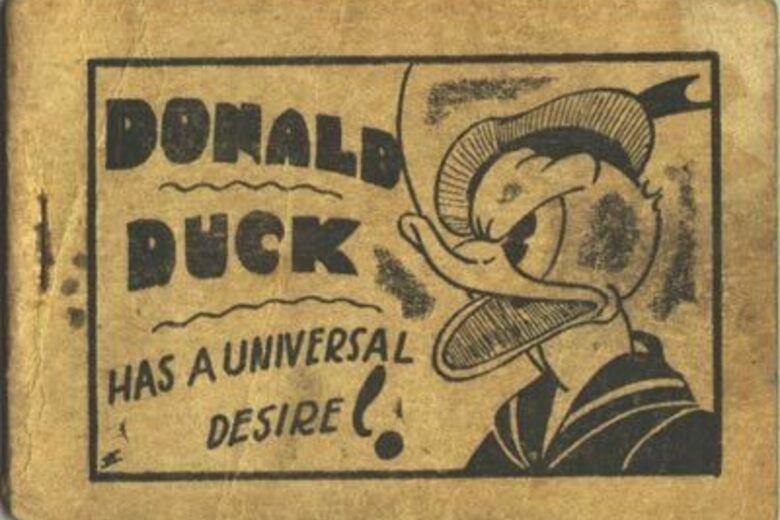
So, when comic books really began to be a thing in the United States, they were just collections of strips that had been run in newspapers. As a result, pretty much all comic books were kind of mainstream — and that meant any queerness was only going to be implied. The exception to that was the Tijuana bibles which were small, illegal books which depicted major comic characters (we’re talking Donald Duck, Betty Boop, Dick Tracy, Popeye, etc) in explicit sexual situations of every kind — including homosexual ones. These started appearing in the early 1930’s — incorrectly believed to be smuggled in from Mexico (hence the name). While these were the not hiding any homosexual activity in them, the characters weren’t actually queer characters — they weren’t even characters belonging to the people who made these books. It was basically just erotic fanart.
Meanwhile, the Golden Age of Comics was taking off for the mainstream comic world. And although it was sometimes tough to see, a handful of actual queer characters were hiding in plain sight — like we’ve done everywhere else throughout history, right? One particular strip, Terry and the Pirates by Milton Caniff, featured a cross-dressing villainous French woman named Sanjak — who was pretty heavily implied to interested in the protagonist’s girlfriend April. Though the strip began running in 1934, Sanjak didn’t show up until the strip published on February 12, 1939. She’s widely considered the first lesbian in comics even though it was never blatantly stated.
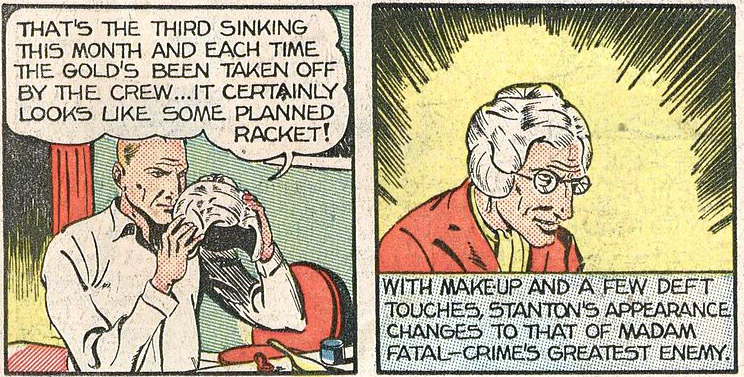
While transgender representation was utterly nonexistent, comics discovered that they loved to tell stories about crossdressing or genderswapping, genderbending, etc. In 1940, the crimefighting Madam Fatal was introduced in Crack Comics #1 — her alter ego was a man named Richard Stranton. This appears to be the first time comics did something like this, but they sure jumped on the bandwagon. Months later, an ongoing supporting cast member from All-American Comics and the comedy series Scribbly — Mrs. Abigail Mathilda “Ma” Hunkel began cross-dressing as the parody superhero Red Tornado. (Later, more serious, incarnations of Red Tornado would go on to be quite successful — Ma Hunkel’s incarnation is mostly forgotten despite possibly being the first female superhero.) That same year, Superman’s enemy the Ultra-Humanite — typical mad scientist type — had his brain transplanted into a woman’s body. A movie star, actually, so that worked out really well for him. (And then his brain was transplanted into an albino gorilla, of course.) It wouldn’t be comic books if there wasn’t something ridiculous like that happening, right? Even Wonder Woman had her own gender-reveal plot twist in 1946 when her enemy Blue Snowman turned out to be a woman. They really learned to love this trope but still managed to have no transgender characters.
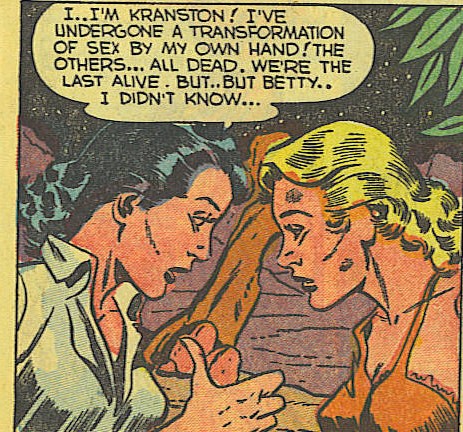
The closest that comics actually got to an actual transgender character was in Space Adventures #3, published by Charlton Comics in 1953. This issue included a story called “Transformation,” said to be inspired by Christine Jorgensen, in which a Dr. Lars Kranston and his girlfriend/assistant Betty crash on the planet Mars. They’re separated, and each thinks they are the only survivor. Dr. Lars, thinking he’s going to go insane without something to occupy his time, goes digging through the wreckage of the ship and discovers and experimental gender reassignment process. Which he undergoes to irreversibly become a woman…because — and I cannot stress enough that this is the actual reason in the story — because he needs something to do with his time or he will lose his mind from boredom. Let me repeat that: Dr. Lars Kranston transitions to life as a woman to avoid being bored. Meanwhile, Betty fights her way through the hostile terrain of this inhospitable desert planet to get back to the ship only to discover that her lover became a woman instead of looking for her. Someone thought this was a good story to tell. Someone thought this was how people we would want to read about would behave. Someone thought this story wouldn’t make me shout obscenities at my computer screen while I was researching this post. Someone was deeply mistaken. I’m still shouting.
Anyways, there’s no need to worry about comics latching onto this “become a woman so you won’t be bored” thing — there was no time. See, while all of this was going down, a man/possible real life supervillain named Dr. Frederic Wertham was campaigning against the comic book industry. He had a whole bunch of, ahem, “research” to prove that they were corrupting the young people of the country, that they were leading to the moral degradation of the United States of America, that Batman and Robin were homosexual lovers, Wonder Woman was a lesbian (though to be fair, early Wonder Woman books had a lot of bondage imagery between women), and — most importantly — that the comic book industry were such fascists that they made Adolf Hitler look like an amateur. I know that’s offensive, and I wish I was exaggerating but he actually said that. And, honestly, I think it’s important that we all know he was that outlandish and that people still believed him. A lot of people. People actually believed that Captain America — Nazi-punching Captain America — was a tool for fascist propaganda. And Dr. Wertham put this all in a book called Seduction of the Innocent which came out in 1954. (As a side note, in 2013 Professor Carol Tilley went through Wertham’s research and found that almost none of it was up to scientific standards and a whole bunch of it was straight up falsified. Utterly unsurprising, if you ask me. But no one knew that yet.) He was promptly called before the Senate Subcommittee on Juvenile Delinquency who he managed to convince of his findings. They said, basically, that the comic book industry could regulate themselves to get their “morality” on track… or the government would step in and do it for them.

And so the major comic book publishers banded together and created the Comic Code Authority (CCA) — or, as it was more often called: The Code. Now, the Code was not some authoritative set of rules that publishers were obligated to follow — but comic book stores would not sell books that did not bear the CCA stamp of approval. And this is an era before the Internet — you couldn’t download a book from the publisher’s web site. You had to go somewhere to get it. So even though the Code didn’t have any real legal authority of any kind, it was absolutely in the best interests of publishers to adhere to it if they wanted to make money.
That was easier said than done, of course. The Code was SO over the top — like SO SO SO over the top. First and foremost, virtually anything sexual was out. Anything outside of the strict gender binary was out. No more cross-dressing Red Tornado (although Jimmy Olsen was allowed in drag on a couple of occasions in the 60’s, but I don’t know the details of how that was permissible.) No more lesbian pirates. But also, no more sympathetic villains — this is why the “moustache-twirling evil villains” became such a thing in comic books — and no villains that were sexy or glamorized being a criminal. So, that meant….bye bye Catwoman! (They may have had a point there — I mean, have you ever seen a Catwoman you didn’t want to be?) There could be no swears or bad language and words like “flick” (where the ink from the “L” and the “I” might run together to make it look like a “U” to accidentally create a naughty word) were also completely forbidden. Love interests for heroes had to be wholesome, of the opposite sex, and model citizens. Romances were meant to “emphasize the value of home and the sanctity of marriage.” And there were so so so so so so many more rules, even stating what could and could not appear in titles — and they also had a rule stating that anything they found was not in the spirit of the Code could be prohibited at their discretion. Here is a good list of the entire Code if you’re interested.
And thus ended the Golden Age of Comics.
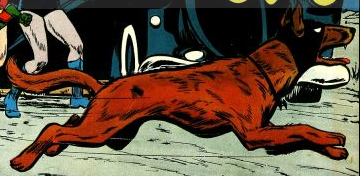
Mainstream publishers like DC Comics were working hard to undo the damage Wertham had caused, and so characters were axed and new ones were created. While getting rid of Catwoman certainly helped with some things, she was the female love interest for Batman….who was already being accused of being too gay. First, they gave him a dog to make him more family friendly — Ace the Bat-Hound. It wasn’t enough to curb the rumors. And so, a year later, in 1956, Kathy Kane came on the scene — acting as his sidekick and love interest Batwoman! Her neice Betty Kane became the first Batgirl and a love interest for Robin. And so they became the official Bat Family. (A term still used for Batman and his cohorts — who I promise we’ll get back to later on!) This didn’t stop speculation — particularly about new characters. The character Element Lad, created in 1963, spent decades having fans interpret him as gay despite the best efforts of his creators. We’ll talk more about him later on too.

The point I’m trying to get to here, really, is that the Code wasn’t just bad for queer representation is was bad for comic books in general. But, yeah, it was also really bad for queer representation….unless you weren’t particularly concerned about profit. The Code also created an entire underground or alternative comic book industry — known colloquially as “underground comix.” Small independent publishers, or independent people just publishing their own work and passing it around or selling them in stores that weren’t actually comic book retailers — like smoke shops. These comics often explored complex social issues and political issues. But sometimes they were just erotic or trying to thumb their nose at Code itself. Queer artists like Tom of Finland and Bill Ward were relegated to drawing pictures for bodybuilding magazines like Physique Pictorial — a good way to show off homoerotic art, but not a great venue to tell a story in. Queer artist Joe Brainard self published two anthology books entitled C Comics — the first in 1964 and the second the following year — but neither featured any overtly queer characters or content. I’m inclined to think, because of this, that even in underground comics it was believed that LGBTQ+ content simply wouldn’t have an audience.
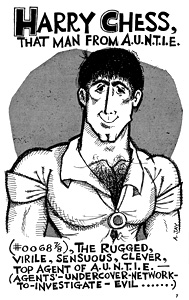
As a result, comics were pretty much devoid of queer content until 1964 with the introduction of Harry Chess, created by Allen J. Shapiro. Harry was introduced in a one-shot comic appearing in Drum, a magazine for gay men. For months later, Shapiro began publishing a strip in each issue of Drum entitled “Harry Chess: That Man From A.U.N.T.I.E.” The comic strip was spoof of the popular The Man from U.N.C.L.E. series, but also parodied political issues of the time and dealt with serious issues facing the gay community. These strips only lasted until 1966. While Drum was running those strips, The Advocate attempted to get some strips of their own running — their first effort was with Joe Johnson penning strips about his characters Miss Thing and Big Dick.
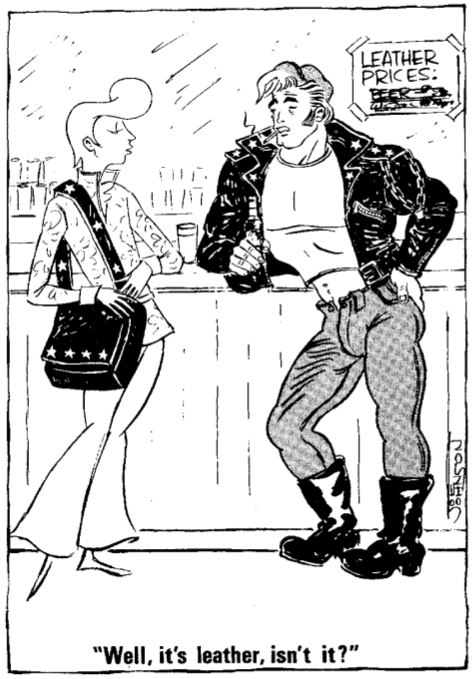

The success of these characters seemed to make it a little bit more acceptable to start having homosexual content in comics. In 1968, Zap Comix #3 included a story by Steve Clay Wilson called — and I swear I’m not making this up — “Captain Pissgums and His Pervert Pirates” which included explicit homosexual sex scenes in an effort to make underground comic artists deal with more culturally taboo topics — which, after all, was the entire purpose behind underground comics! Ultimately, it wasn’t Captain Pissigums that spurred underground artists into creating gay content but it was about to happen.
It was actually the Code itself. By 1971, the Stonewall riots had come and gone and virtually every area of LGBTQ+ culture had changed as a direct result — we were inspired to start standing up for ourselves, being loud, taking up space. But not in comics, not yet. Due primarily to mainstream publisher’s pushing the envelope in the late 60’s, the Code was revised in 1971. Some of the restrictions were loosened up, a few were done away with entirely. This spelled the beginning of the end for the Code — and the actual beginning for queer comic books.
Stay tuned for the explosive next chapter!
4 thoughts on “Queers in Comics: The Code”